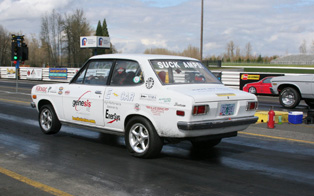
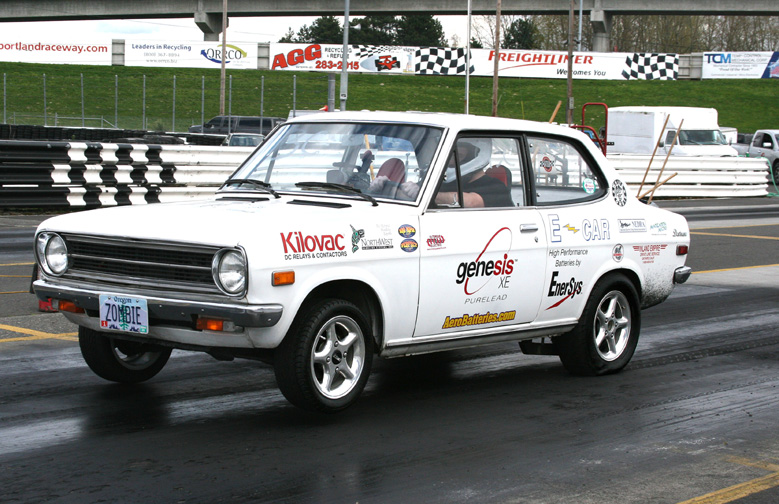
March 2007, PIR - 12.161 @ 106.59 mph ET (above photo) courtesy of Carol Brown (photogal@iglide.net)
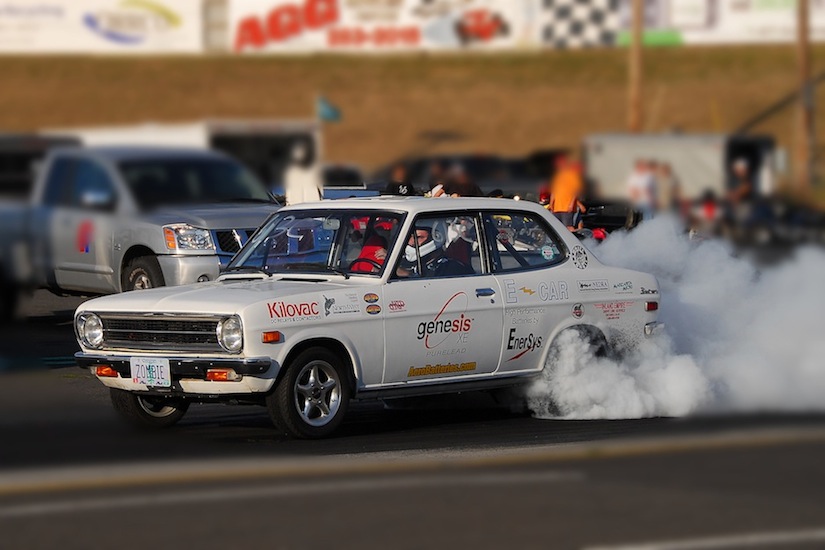
"White Zombie is a real 'sleeper', as one would never guess how fast it can go and someone might underestimate it's abilities. It's small, unassuming appearance doesn't readily give any clue to it's speed! The little white Datsun really stands out against all of the big muscle cars."
(Quote from Carol Brown, PIR track photographer)
Motor: 'Siamese 8' dual armature with selectable series/parallel wiring. Since the Siamese 8 was first designed and installed in early 2005 (lower left), there have been many changes to the Zombie's under-hood area: (lower right)


Drive type: Direct drive. Electric reverse.
Driveshaft: Single piece all aluminum driveline from 'Inland Empire Drivelines'. Driveline loop.
Rear axle: Dutchman heavy duty Street-strip Ford nine inch rear axle setup with 31 spline racing axles, 4:11 gears and Detroit locker. Air shocks & traction bars.
Wheels & tires:Front - Eagle 5 spoke 13 x 5.5 alloys with 4 bolt Nissan rear drive offset and 175/50/13 Nitto Exit GS radials.
Rear - Eagle 5 spoke 14 x 6 alloys with 5 bolt Ford front drive offset. BF Goodrich 'G Force Drag Radials' (24" dia.)
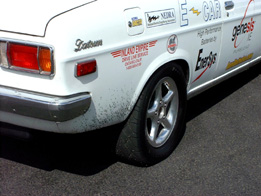
Batteries:Battery pack change from the previous 30, 12 volt 26 ahr, 24.5 lb. Hawker 'Aerobatteries' @ 360V nominal, to 60 of the new Enersys high current 'Genesis 12V 16XE' @ 16 ahr and 14.2 lbs. each. Total pack volts still at 360 (2 X 360V in parallel) and the combined weight of both packs at 852 lbs. (left) The new brick-shaped Genesis batteries are quite a bit smaller than the cube-shaped Aerobatteries. (right) Look familiar? The new Genesis batteries are the same size as the originals we used in the '98 - '02 version of White Zombie, only this time around they're orange and have been made even tougher than before. These little batteries make up to 40% MORE power lb. per lb. (750 amps max. from a 14 lb. battery vs 1000 amps from a 25 lb. battery) than the larger sized models they replace. The cube shaped 12V batteries weighed 25 lbs. each and dropped to ~ 6 volts @ 1000 amps (max safe draw before melt-down occurs), while two of the smaller 12V batteries wired in parallel weigh a bit more at 28 lbs. but only drop to ~ 7 volts and can make a whopping 1500 amps! (750 amps X two).


(below left) The rear seat area battery pack that holds 36 of the total of 60 batteries...note the cool rear window reflection on the clear Lexan cover as viewed looking back through the car. (below center) Rear seat area pack as viewed from the passenger side rear window (below right) The trunk floor batteries installed with light but sturdy hold-down brackets that secure the batteries in place:



Controller:Zilla Z2k 2000 amp controller with Hairball interface. Programable automatic series-parallel contactor control. Quick-pull emergency disconnect. A small inverter provides 120 vac to run a nearly silent AC aquarium pump inside a windshield washer tank for liquid cooling of the controller.
12 volt system: Custom 40 amp DC-DC converter. 16 ahr Hawker Aerobatteries 12V battery as the 12V system back-up.
Other Mods: (1) Removed the rear 12V port and portable Orbital 12V system backup supply option.
(2) Redesigned and built all new battery compartments for the new 60-battery system. Shown below is metal expert Marko Mongillo and the build process of the new ulta-light weight rear seat area battery compartment. The final box (not shown) has a thin sheet of aluminum over the open floor section to seal the chamber from the passenger compartment and a clear Lexan protective top cover. To help keep the car from wheel standing any higher than it has, more battery weight has been shifted ahead of the rear axle by installing 36 of the total of 60 batteries in this compartment. As seen above, the other 24 batteries are located in the sunken trunk well.
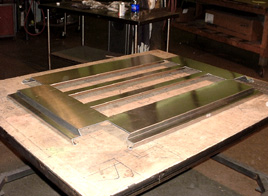


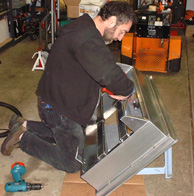

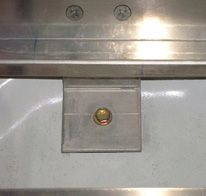
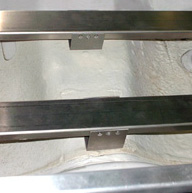

We were able to clean up and re-use most of the old copper bus bars saved from the '98 -'02 version that ran with a single string of 28 little Genesis batteries (336v), but with this new double string of 30 of the new Genesis batteries, more than double that amount was needed. Additionally, the completely different orientation of the batteries in two separate containers meant that more of the 'cross-over' specially bent and shaped size bars would need to be built (left). (center) Box of extra bars we made. (right) Completed split trunk battery pack (2 X 144V) with bus bars and power cables. Note the dual positive and negative 2/0 leads. The positive leads are 2/0 orange instead of red, as they are not 'positive most' and are inter-connect cables going forward to the rear seat split pack (2 X 216V):

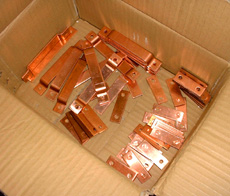

The twin negative leads in the left photo below are the 'negative most' of both 360V packs and tie together at a power stud where the 4/0 negative power cable takes the juice forward to the controller. The right photo below is a close-up look at the two 'positive most' cables that exit rearward from the rear seat pack and connect to the twin EV250 Kilovac contactors. Note that there are insulating grommets, plus thick heat shrink that protect the cables as they pass through the aluminum. The contactors keep the twin 360V packs separated while the keyswitch is in the 'off' position, or when the keyswitch is 'on' but the rear bumper mounted exterior safety on-off switch is in the 'off' position. If the keyswitch is 'on' and the safety switch is also 'on', the contactors pull in and tie the two pack positives together through fuses connected to the battery pack shunts. The orange 4/0 positive cable connected on the other side of the shunts runs forward to the emergency disconnect, then onto the motor controller:


(3) Removed the previous single 175 amp Anderson charge port (left) and replaced it with dual 50 amp Anderson connectors (center), one for each 360 volt pack. (right) When the charge cable is plugged into the ports, it automatically parallels the two packs together for charging:
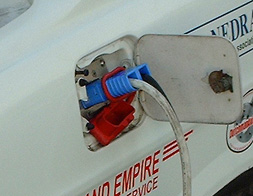
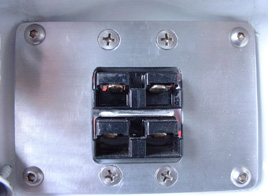

(4) Re-wired all the 12V system and signal wiring in the car for a much cleaner and more reliable design.
(5) Extensive weight reductions in all areas, especially the battery compartments.
Car weight: 2580 lbs. (weighed on digital scales 5-17-07)
2-7-07 'Northwest Z' club meeting...White Zombie on display at the Wilsonville, OR Izzy's Pizza place where the monthly Z Car club holds their meetings. Plasma Boy and driver Tim Brehm are the scheduled guest speakers.
3-2 thru 3-4-07 '51st Portland Roadster Show'...White Zombie on display at this over-the-top hotrod show. (left) The show organizer positioned White Zombie right at the entrance to the show! (right) A closer look at the display we had set up:

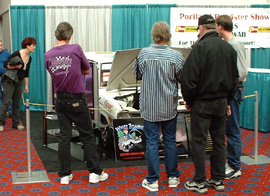
For more pictures, click on the 'Photos' button, then select 'White Zombie featured at Portland Roadster Show'. (below) Tim Brehm with the 1st place trophy White Zombie took for 'Bracket Racer Electric':
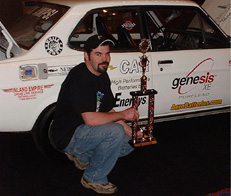
3-18-07 'NHRA Winter Opener Drags at PIR'...White Zombie makes it maiden runs on the new twin 360V pack of Genesis batteries and resets the PS/A3 world record with a 12.161 @ 106.59 mph pass. (below left) Tim and Zombie lined up in the Pro lane. (below center) This terrific burnout shot was taken by PIR's favorite photographer Carol Brown. (below right) Tim and a couple of new drag racing friends we met after the last run of the night.



We nailed that 12.161 with the controller's battery current limit adjusted to restrict the maximum current drawn from the pack to 1000 amps (500 amps from each battery) for the initial break-in...in subsequent races, the pack will be gradually cranked up to its max of 1500 amps (750 amps from each battery).
4-1-07 'May issue of Car and Driver Magazine Features White Zombie' (http://www.caranddriver.com/features/all/2007/>batteries_included_feature)... (below left) The much anticipated story by C & D writer Ted West about his night 1/4 mile drag racing White Zombie against the gas cars, hits the stands. We even got a small mention on the cover...see highlighted circle area. (below center) The opening photo with Tim Brehm boiling the hides. (below right) From the printed version of the magazine story showing writer Ted West getting slammed back against the seat. The internet version had this different caption, "Under ferocious acceleration - 772 pound-feet of torque under the pedal - the author canšt seem to hold his chin down". Both terrific photos were shot by pro photograhper Morgan Segal:



From the behind-the-scenes trivia files.... The small inset photo (center above) showing the end of a motor controller and its power cables from the opening page of the Car and Driver story (shown enlarged in the below left photo) is from Jay Donaway's show quality Ghia project. The immaculately detailed machine was on display as a work-in-progress at the '06 'Electric Breakfast' that was part of the two day racing action of the 'Late Night Nationals'. The controller is none other than White Zombie's original 'Godzilla' 1400 amp controller. If you look closely, you can see that a ring type terminal connector at one of the controller's lugs, is new, un-crimped, and not attached to a cable yet. (below right) Plasma Boy had his digital camera handy and took a picture of C & D photgrapher Morgan Segal taking the picture that appeared in the magazine!

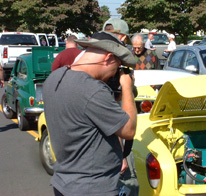
5-15-07 'White Zombie featured on Vinny's Garage'...In an exciting interview, Plasma Boy and White Zombie are the feature story of Vinny's podcast #19 (http://www.vinnysgarage.com/)
6-23-2007 'Gasless on Greenwood' car show in Seattle...White Zombie & drag racing videos on display at this wild hotrod show that attracts more than 15,000 car fans. Here's Plasma Boy himself with his trusty steed:
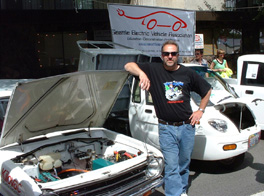
6-29-07 'PIR Late Night Drag Races'...With its freshly rebuilt Siamese 8 motor advanced from its previous 10 degrees to a more aggressive 15 degrees, but with no other changes and the controller battery limit still set to 1000 amps (up to 1500 amps available), White Zombie became the first street legal street bodied electric car to break into the 11s with a new world record run of 11.948 @ 109.75 mph! (below left) The last run of the night was a grudge match between White Zombie and the icon of the muscle car, a '64 Pontiac Tempest (think GTO) stuffed from fender to fender with a massive 455 cid V8. The badass orange machine ran a strong 12.5 @ 108 mph but it was no match for White Zombie's second dip into the 11s where the 360 volt electric car clocked an 11.960 @ 110 mph! (below right) To quote Wall Street Journal's John Fialko when commenting about the Pontiac's power plant, "an acre of motor under the hood".
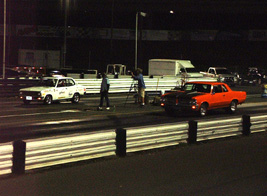

(1) At the 3-18-07 races, damage was done to the rear motor section of the Siamese 8 after a high voltage high rpm flash-over fireball incident. Tim wisely aborted the last run of the day after a super quick 7.511 1/8 mile beginning. Getting off the throttle at the 2/3 point down the track and coasting down to just 94 mph (trap speeds had been near 107 mph) still netted a 12.2 second ET! (lower center) The black zorch marks on the outside lead to vaporized brush holders on the inside! (below right) And here's what 2000 amps at near 170 volts under load does to the brush rigging when 'bad ju ju' happens:



2-18-07 On weight reductions..."The new pack would have added about 90 lbs. weight to the car, but careful attention to detail and lots of planning have cut that down considerably. This past week and weekend's efforts, along with Marko's metal shop expertise have produced all new battery compartments for the car. The previous rear seat area compartment weighed 34 lbs....the new one? Just 14 lbs.! The rear sunken trunk area tray with hold-downs weighed about 16 lbs....the new one? Just under 5 lbs.! We've trimmed more than 30 lbs. just in the battery compartments' redesign, and we're still not done with the weight reductions. How'd we do it? Instead of 3/16 thick aluminum and a basic box with thick pedestal mounts and such, we used thin sheet aluminum with lots of bends, creases, gussets, and supports. We also cut out material where we could and used lighter weight material in general. I'm still considering an aluminum Ford 9 inch casting that will trim up to 45 lbs. weight off that heavy rear end. It's entirely possible to get the car to weigh less than the previous version, even with 840 lbs. of hi pro lead in the car."
3-21-07 On the first 1/4 mile runs of the year..."The feisty brick-sized Genesis batteries were still waking up when they slammed home a 12.308 @ 104.20! Whoa...a 12.3? At 104+ mph? On the second run? On still not warmed-up batteries? (below left) Tim was matched up against a primer grey '69 Chevy Nova with a built V8, and absolutely wasted it in front of lots of race fans. (below right - photo by Carol Brown) Mr. Brehm cuts a good light, the sticky G Force drag radials warp and refuse to let go of the pavement, the nose pulls up, and bye-bye Nova! The Chevy turned in a respectable 13.061 @ 101.37 mph against the much quicker electric Datsun.

